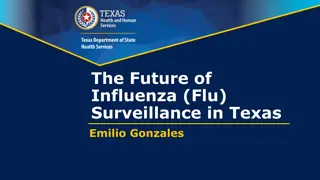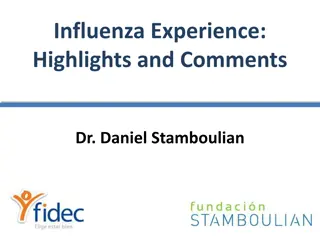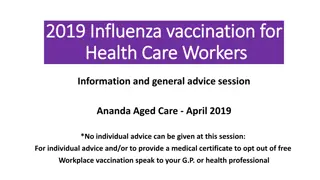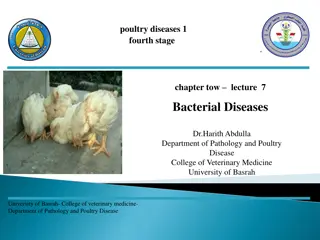Influenza A(H3N2)v at Jackson County Junior Fair 2022
Learn about an Influenza A(H3N2)v outbreak investigation at a fair. Understand the control steps taken and public health recommendations. Discover the partners involved and outbreak timeline details. Explore case definitions and surveillance methods. Popular
0 views • 14 slides
Avian Hazard Advisory System (AHAS) Update
The latest updates to the Avian Hazard Advisory System (AHAS) providing crucial bird hazard information for flight safety. Learn about calculating NEXRAD risk, regional mosaics, flying areas, and risk management.
0 views • 23 slides
Impact of Highly Pathogenic Avian Influenza 2023 on South African Broiler Industry
The presentation by the South African Poultry Association sheds light on the detrimental effects of Highly Pathogenic Avian Influenza (HPAI) on the broiler industry in South Africa. Factors such as load shedding, water supply interruptions, and now, the outbreak of H7N6, have exacerbated the financi
4 views • 19 slides
Avian Influenza Overview and Outbreak History in South Africa
Avian Influenza, specifically Highly Pathogenic Avian Influenza (HPAI) outbreaks in South Africa, have been documented since 2004, affecting primarily ostriches and poultry. Wild bird transmission remains a concern, with risk factors such as rainfall, temperature, wetlands, and poultry movements con
2 views • 25 slides
United States Influenza Disease Burden by Season
Estimated influenza disease burden in the United States from the 2010-11 season through the 2022-23 season, including symptomatic illnesses, medical visits, hospitalizations, and deaths. The data provides insights into the impact of influenza over the years and preliminary estimates for the upcoming
8 views • 4 slides
Understanding Viral Diseases in Poultry: Newcastle Disease and Avian Influenza
Viral diseases like Newcastle Disease (ND) and Avian Influenza (AI) pose significant threats to poultry farming, impacting bird health and production. ND, caused by Avian paramyxovirus type 1, is highly contagious and manifests in various forms affecting birds' respiratory and nervous systems. On th
7 views • 24 slides
Update on Avian Influenza A(H5N1) Outbreak in the U.S.
Avian Influenza A(H5N1) has been detected in domestic livestock and a few human cases have been reported in the U.S. The CDC issued a technical report detailing the cases and their symptoms. No human-to-human transmission has been identified so far. The situation is being closely monitored and updat
0 views • 17 slides
Understanding Pandemic Influenza: Causes, Impacts, and Preparedness
Influenza pandemics have historically caused significant casualties, with the most notable being the 1918 H1N1 pandemic flu that resulted in approximately 50 million deaths. Understanding how diseases like the flu can cause a pandemic is crucial, including the groups most vulnerable and the necessar
1 views • 15 slides
Understanding Influenza: Key Concepts and Impact on Public Health
Influenza is a contagious respiratory illness caused by influenza viruses, with symptoms spread through droplets in the air or on surfaces. Vaccination and surveillance play vital roles in controlling flu outbreaks. Understanding the structure and types of influenza viruses, along with the importanc
0 views • 16 slides
What is Influenza (Flu) in Children
Influenza, or the flu, is a contagious respiratory illness caused by influenza viruses. In children, it can lead to symptoms like fever, cough, sore throat, runny nose, and body aches. The flu can sometimes cause more severe complications, so it\u201
2 views • 8 slides
Understanding Orthomyxoviridae: Key Points on Influenza Viruses
Influenza viruses belong to the Orthomyxoviridae family and are major contributors to respiratory epidemics and pandemics. They consist of three genera - Influenza A, B, and C - with distinct morphological characteristics and genetic makeup. By exploring the properties, classification, and morpholog
0 views • 62 slides
Anatomy of the Respiratory System in Birds: A Detailed Overview
The respiratory system in birds, including poultry, consists of various components such as nostrils, nasal cavities, larynx, trachea, syrinx, air sacs, and lungs. Each part plays a crucial role in respiration, with unique features adapted to avian physiology. Understanding the anatomy of the avian r
1 views • 19 slides
Guidelines for Avian Euthanasia and Mass Depopulation
Avian euthanasia and mass depopulation are crucial processes in animal health emergencies. This involves transitioning animals painlessly, maintaining welfare, and preventing disease spread. Methods such as injectables, inhalants, and physical methods are utilized, all aiming to provide a humane and
0 views • 22 slides
Protect Yourself and Others: Influenza Prevention Tips for Long-Term Care Facilities
Learn about the importance of influenza vaccination, common misconceptions, signs and symptoms of the flu, and preventive measures for both residents and staff in long-term care facilities. Stay informed and take proactive steps to safeguard against the flu virus.
0 views • 12 slides
Preventing Influenza at Long-Term Care Facilities: A Comprehensive Guide
Learn how to prevent influenza at long-term care facilities by promoting vaccination, practicing good hygiene, and recognizing flu symptoms. Visitors, residents, and staff all play crucial roles in safeguarding against the flu, which can have serious consequences, especially for vulnerable populatio
0 views • 12 slides
Preventing Influenza in Long-Term Care Facilities: Importance of Vaccination and Hygiene Practices
Influenza, commonly known as the flu, is a contagious respiratory illness that can have severe consequences, especially for vulnerable populations like those in long-term care facilities. This post emphasizes the importance of flu vaccination for residents, staff, and visitors, along with good hygie
0 views • 12 slides
Viral Infections of the Respiratory System Lecture Summary & Quiz
This lecture covers viral infections of the respiratory system, focusing on Avian flu, Influenza Virus, Respiratory Syncytial Virus, Human metapneumovirus, Parainfluenza viruses, Measles, and Mumps virus. It includes information on the structure, symptoms, lab diagnosis, treatment, and prevention of
0 views • 11 slides
Understanding Mycoplasma Infections in Avian Species
Mycoplasma infections, caused by species like Mycoplasma gallisepticum and Mycoplasma synoviae, are common in poultry, particularly affecting turkeys and chickens. These infections lead to respiratory issues, sinusitis, and reduced production rates. Learn about transmission, clinical findings, and v
0 views • 13 slides
Avian Interactions with Wind Energy Development
The slides discuss avian interactions with wind energy development, highlighting challenges faced by bird species due to climate change. Strategies to minimize these interactions are explored, emphasizing the environmental benefits of wind energy and comparing avian fatality rates with other enginee
0 views • 19 slides
Understanding One Health Approach for Food Security and Public Health
The concept of One Health emphasizes the interconnectedness of human, animal, and environmental health. This approach explores how animal-borne illnesses impact food security, public health, and overall well-being. By examining diseases like avian influenza, Newcastle disease, and brucellosis, we se
0 views • 15 slides
Texas Influenza Surveillance Overview
In this overview, we delve into the details of influenza surveillance in Texas, covering various aspects such as flu testing, notifiable conditions, and the 2022-2023 flu season review. The information provided includes surveillance structures, reporting requirements, and the vital role of testing i
0 views • 17 slides
Understanding Avian Influenza: Symptoms, Diagnosis, and Prevention
Avian influenza, or bird flu, is a viral disease affecting birds' respiratory, digestive, and nervous systems. It presents in two forms - Highly Pathogenic Avian Influenza Virus (HPAIV) and Low Pathogenic Avian Influenza Virus (LPAIV). The virus has two important surface antigens, Hemagglutinin (H)
0 views • 7 slides
Influenza Vaccination Campaign 2016: Aim, Objectives, and Implementation
The Influenza Vaccination Campaign in 2016 aimed to mitigate the effects of influenza by reducing morbidity and mortality, limiting virus transmission, and easing the burden on the healthcare system. The campaign was managed by a National Coordination Steering Committee, with focus on priority group
0 views • 13 slides
Understanding Avian Influenza: Symptoms, Transmission, and Prevention
Avian influenza, commonly known as bird flu, is a contagious disease caused by flu viruses that primarily affect birds but can also spread to humans. Learn about the symptoms in humans, how the virus spreads, and preventive measures to stay safe. Stay informed and take necessary precautions to reduc
1 views • 15 slides
Rapid Influenza Outbreak Detection in Long-Term Care Facilities
The research investigates the effectiveness of rapid diagnostics in detecting influenza outbreaks in long-term care facilities. A non-blinded, randomized controlled trial in Wisconsin LTCFs showed that the intervention led to higher oseltamivir prophylaxis use, decreased ED visits, hospitalizations,
0 views • 6 slides
Understanding Equine Influenza: An Overview of Respiratory Tract Infections in Horses
Equine influenza is a contagious upper respiratory infection in horses caused by influenza viruses. This article covers the anatomy of the equine respiratory tract, signs, diagnosis, treatment, prevention, and prognosis of equine influenza. It also discusses the histological structure of the respira
0 views • 18 slides
Vaccination Status and Influenza Infection Among Pregnant Japanese Women
This study explores the impact of seasonal influenza vaccination on infection rates among pregnant Japanese women, focusing on primiparous and multiparous individuals. It discusses the background of influenza-related complications in pregnant women, presenting data on maternal mortality during the H
0 views • 30 slides
Epidemiology Update on Influenza Surveillance and Activity in Virginia
Providing insights into the influenza season in Virginia, this update highlights the importance of conducting surveillance, data sources for monitoring influenza-like illness, and comparisons of influenza activity levels over multiple seasons. By tracking influenza viruses and their impact, the goal
0 views • 47 slides
Birds of Girinagara: A Study on Avian Species and Habitats
Documenting and analyzing the bird life in Girinagara, this study captures various species such as Pale Billed Flowerpecker and Red Whiskered Bulbul. With detailed observations of their activities and habitats, the research sheds light on the rich avian diversity present in the area.
0 views • 11 slides
Cold Chain Management for Influenza Vaccinations 2016 Logistics
Proper logistics management is crucial for the success of influenza vaccination programs. This includes cold chain maintenance, vaccine handling, storage guidelines, temperature monitoring, and data management practices to ensure the efficacy and safety of the vaccines. Adherence to these protocols
0 views • 12 slides
Emergency Response in a Multigenerational Family during an Influenza Outbreak
When a paramedic team is called to assess a family during an influenza epidemic, they encounter individuals of different ages with respiratory symptoms. The team evaluates vital signs, identifies alarming signs of dehydration and altered mental status in the baby, assesses respiratory conditions in
0 views • 18 slides
Understanding Viral Infections of the Respiratory System
Respiratory viral infections are common and primarily caused by viruses, leading to morbidity and time off work. They can range from mild upper respiratory tract infections to severe lower respiratory tract infections like pneumonia. Various viruses like influenza, parainfluenza, respiratory syncyti
0 views • 23 slides
Understanding Zoonotic Diseases and Prevention Strategies
Zoonotic diseases pose a risk as they can be transmitted from animals to humans under natural conditions. Awareness of transmission routes is crucial. Direct contact, ingestion, aerosol, and indirect transmission through fomites or vectors are common means of spreading these diseases. Animals may no
0 views • 15 slides
Leucocytozoon: Haemoparasite in Birds from Bihar Animal Sciences University
Leucocytozoon, a haemoparasite found in birds, is studied at Bihar Animal Sciences University under Dr. Ajit Kumar. The parasite's morphology, life cycle, and host interactions are detailed, providing valuable insights into its impact on avian health. The research sheds light on the genus Leucocytoz
0 views • 13 slides
Preventing Influenza at [Name of Critical Access Hospital]
Influenza, commonly known as the flu, is a contagious respiratory illness that affects millions annually, leading to hospitalizations and even deaths, particularly among older individuals. The 2016-2017 flu season alone saw staggering numbers of influenza cases and associated medical visits. Protect
0 views • 12 slides
Enhancing Influenza Surveillance in Texas: Strategies and Goals
Emilio Gonzales presents a comprehensive plan for advancing influenza surveillance in Texas, focusing on considerations, goals for the upcoming flu season, and strategies to increase participation in surveillance programs. The plan includes enhancing respiratory disease surveillance, expanding senti
0 views • 15 slides
Understanding Influenza: From Pandemics to Avian Flu Outbreaks
Influenza is a viral respiratory illness that can range from seasonal flu to pandemic outbreaks like the 2009 swine flu (H1N1) epidemic. The dangers and prevention methods of specific strains, such as H5N1 avian flu, have been witnessed since 2003. This summary delves into the characteristics, impac
0 views • 13 slides
Insights into Influenza: History, Pandemics, and Vaccines
Explore the impact of influenza through history, from the 1918 pandemic to current strains circulating. Learn about the disease burden, virus subtypes, and recommended vaccine composition. An overview of Dr. Daniel Stamboulian's contributions and disclosures is included, shedding light on the ongoin
0 views • 14 slides
Importance of 2019 Influenza Vaccination for Health Care Workers
Influenza, commonly known as the flu, is a contagious respiratory illness caused by influenza viruses that can spread through aerosols or surface contact. Common symptoms include fever, headache, fatigue, muscle pain, cough, and sore throat. The flu can be severe, leading to hospitalizations and eve
0 views • 19 slides
Understanding Avian Salmonellosis in Poultry: Causes, Symptoms, and Prevention
Avian Salmonellosis, a bacterial disease in poultry, is categorized into distinct forms such as Pullorum Disease, Fowl Typhoid, and Paratyphoid Infection. It is characterized by high mortality rates, affecting both young chicks and mature fowls. The disease spreads through infected eggs, leading to
0 views • 11 slides



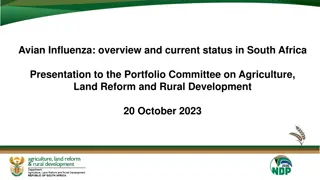
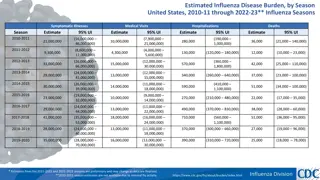
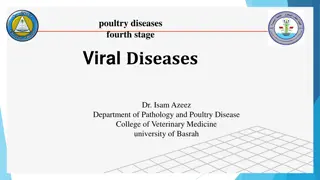


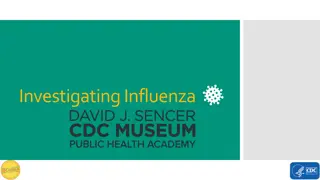
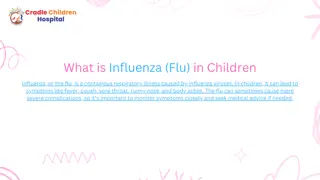

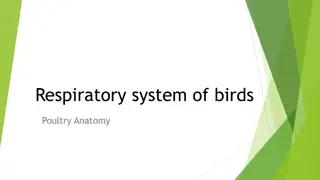
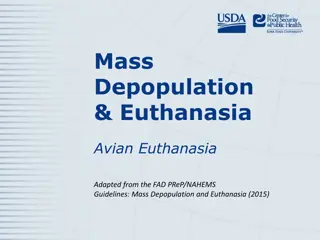
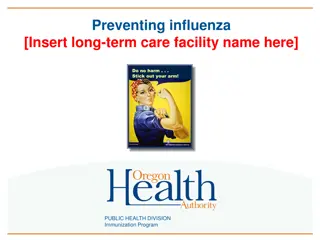

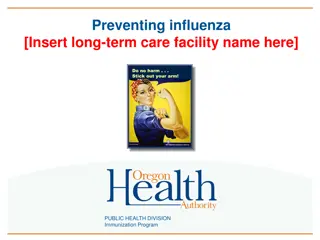
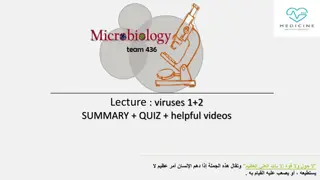
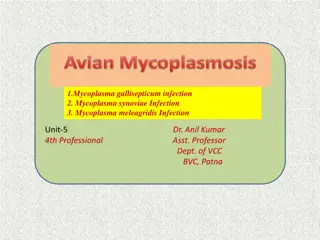
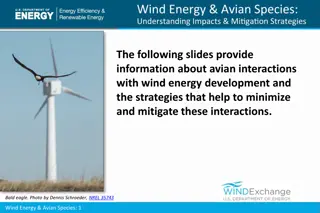



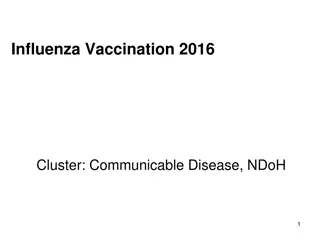
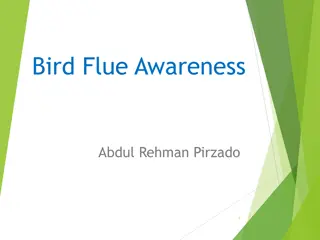
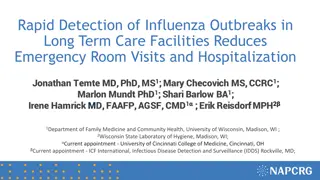

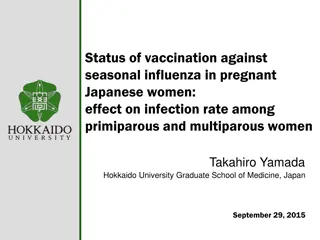
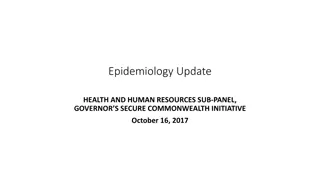

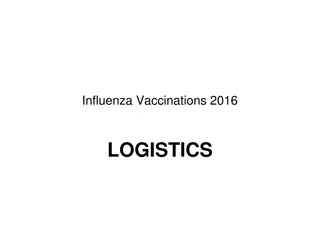
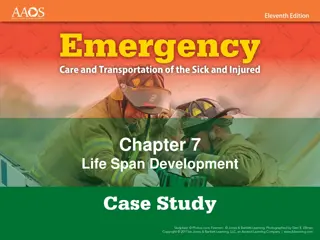

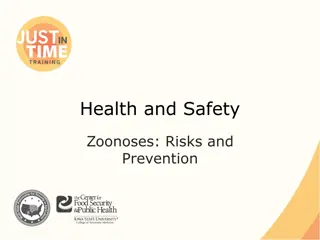
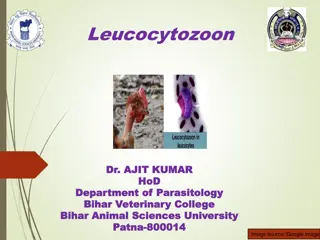
![Preventing Influenza at [Name of Critical Access Hospital]](/thumb/233818/preventing-influenza-at-name-of-critical-access-hospital.jpg)
